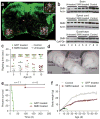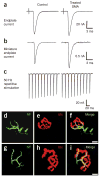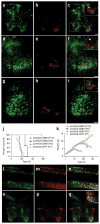Rescue of the spinal muscular atrophy phenotype in a mouse model by early postnatal delivery of SMN
- PMID: 20190738
- PMCID: PMC2889698
- DOI: 10.1038/nbt.1610
Rescue of the spinal muscular atrophy phenotype in a mouse model by early postnatal delivery of SMN
Retraction in
-
Retraction Note: Rescue of the spinal muscular atrophy phenotype in a mouse model by early postnatal delivery of SMN.Nat Biotechnol. 2022 Nov;40(11):1692. doi: 10.1038/s41587-022-01497-7. Nat Biotechnol. 2022. PMID: 36203015 Free PMC article. No abstract available.
Abstract
Spinal muscular atrophy (SMA), the most common autosomal recessive neurodegenerative disease affecting children, results in impaired motor neuron function. Despite knowledge of the pathogenic role of decreased survival motor neuron (SMN) protein levels, efforts to increase SMN have not resulted in a treatment for patients. We recently demonstrated that self-complementary adeno-associated virus 9 (scAAV9) can infect approximately 60% of motor neurons when injected intravenously into neonatal mice. Here we use scAAV9-mediated postnatal day 1 vascular gene delivery to replace SMN in SMA pups and rescue motor function, neuromuscular physiology and life span. Treatment on postnatal day 5 results in partial correction, whereas postnatal day 10 treatment has little effect, suggesting a developmental period in which scAAV9 therapy has maximal benefit. Notably, we also show extensive scAAV9-mediated motor neuron transduction after injection into a newborn cynomolgus macaque. This demonstration that scAAV9 traverses the blood-brain barrier in a nonhuman primate emphasizes the clinical potential of scAAV9 gene therapy for SMA.
Conflict of interest statement
The authors declare no competing financial interests.
Figures



Comment in
-
Genetic therapy for spinal muscular atrophy.Nat Biotechnol. 2010 Mar;28(3):235-7. doi: 10.1038/nbt0310-235. Nat Biotechnol. 2010. PMID: 20212484 No abstract available.
Similar articles
-
Improving single injection CSF delivery of AAV9-mediated gene therapy for SMA: a dose-response study in mice and nonhuman primates.Mol Ther. 2015 Mar;23(3):477-87. doi: 10.1038/mt.2014.210. Epub 2014 Oct 31. Mol Ther. 2015. PMID: 25358252 Free PMC article.
-
Intravenous scAAV9 delivery of a codon-optimized SMN1 sequence rescues SMA mice.Hum Mol Genet. 2011 Feb 15;20(4):681-93. doi: 10.1093/hmg/ddq514. Epub 2010 Nov 30. Hum Mol Genet. 2011. PMID: 21118896
-
AAV9-Stathmin1 gene delivery improves disease phenotype in an intermediate mouse model of spinal muscular atrophy.Hum Mol Genet. 2019 Nov 15;28(22):3742-3754. doi: 10.1093/hmg/ddz188. Hum Mol Genet. 2019. PMID: 31363739 Free PMC article.
-
Therapy development for spinal muscular atrophy in SMN independent targets.Neural Plast. 2012;2012:456478. doi: 10.1155/2012/456478. Epub 2012 May 31. Neural Plast. 2012. PMID: 22701806 Free PMC article. Review.
-
Two breakthrough gene-targeted treatments for spinal muscular atrophy: challenges remain.J Clin Invest. 2018 Aug 1;128(8):3219-3227. doi: 10.1172/JCI121658. Epub 2018 Jul 9. J Clin Invest. 2018. PMID: 29985170 Free PMC article. Review.
Cited by
-
Trends on Novel Targets and Nanotechnology-Based Drug Delivery System in the Treatment of Parkinson's disease: Recent Advancement in Drug Development.Curr Drug Targets. 2024;25(15):987-1011. doi: 10.2174/0113894501312703240826070530. Curr Drug Targets. 2024. PMID: 39313872 Review.
-
Current developments of gene therapy in human diseases.MedComm (2020). 2024 Aug 16;5(9):e645. doi: 10.1002/mco2.645. eCollection 2024 Sep. MedComm (2020). 2024. PMID: 39156766 Free PMC article. Review.
-
AAV gene replacement therapy for treating MPS IIIC: Facilitating bystander effects via EV-mRNA cargo.J Extracell Vesicles. 2024 Jul;13(7):e12464. doi: 10.1002/jev2.12464. J Extracell Vesicles. 2024. PMID: 38961538 Free PMC article.
-
Improved gene therapy for spinal muscular atrophy in mice using codon-optimized hSMN1 transgene and hSMN1 gene-derived promotor.EMBO Mol Med. 2024 Apr;16(4):945-965. doi: 10.1038/s44321-024-00037-x. Epub 2024 Feb 27. EMBO Mol Med. 2024. PMID: 38413838 Free PMC article.
-
Advances of Genome Editing with CRISPR/Cas9 in Neurodegeneration: The Right Path towards Therapy.Biomedicines. 2023 Dec 17;11(12):3333. doi: 10.3390/biomedicines11123333. Biomedicines. 2023. PMID: 38137554 Free PMC article. Review.
References
-
- McCarty DM, et al. Adeno-associated virus terminal repeat (TR) mutant generates self-complementary vectors to overcome the rate-limiting step to transduction in vivo. Gene Ther. 2003;10:2112–2118. - PubMed
-
- Lefebvre S, et al. Identification and characterization of a spinal muscular atrophy-determining gene. Cell. 1995;80:155–165. - PubMed
Publication types
MeSH terms
Substances
Grants and funding
LinkOut - more resources
Full Text Sources
Other Literature Sources
Medical
Miscellaneous


